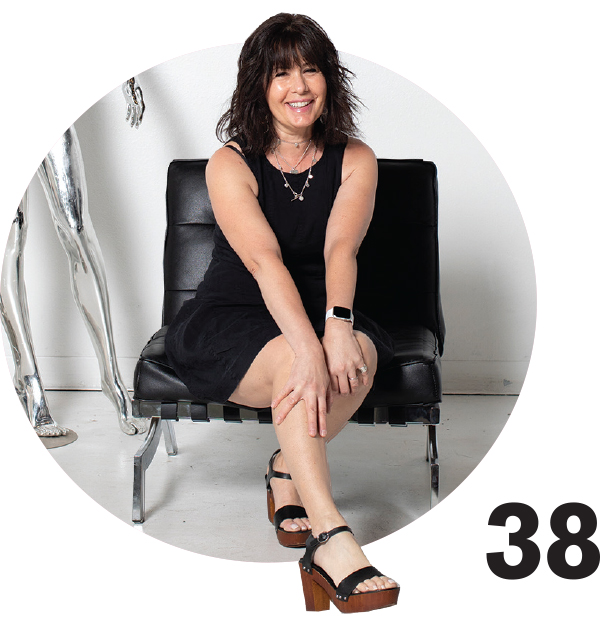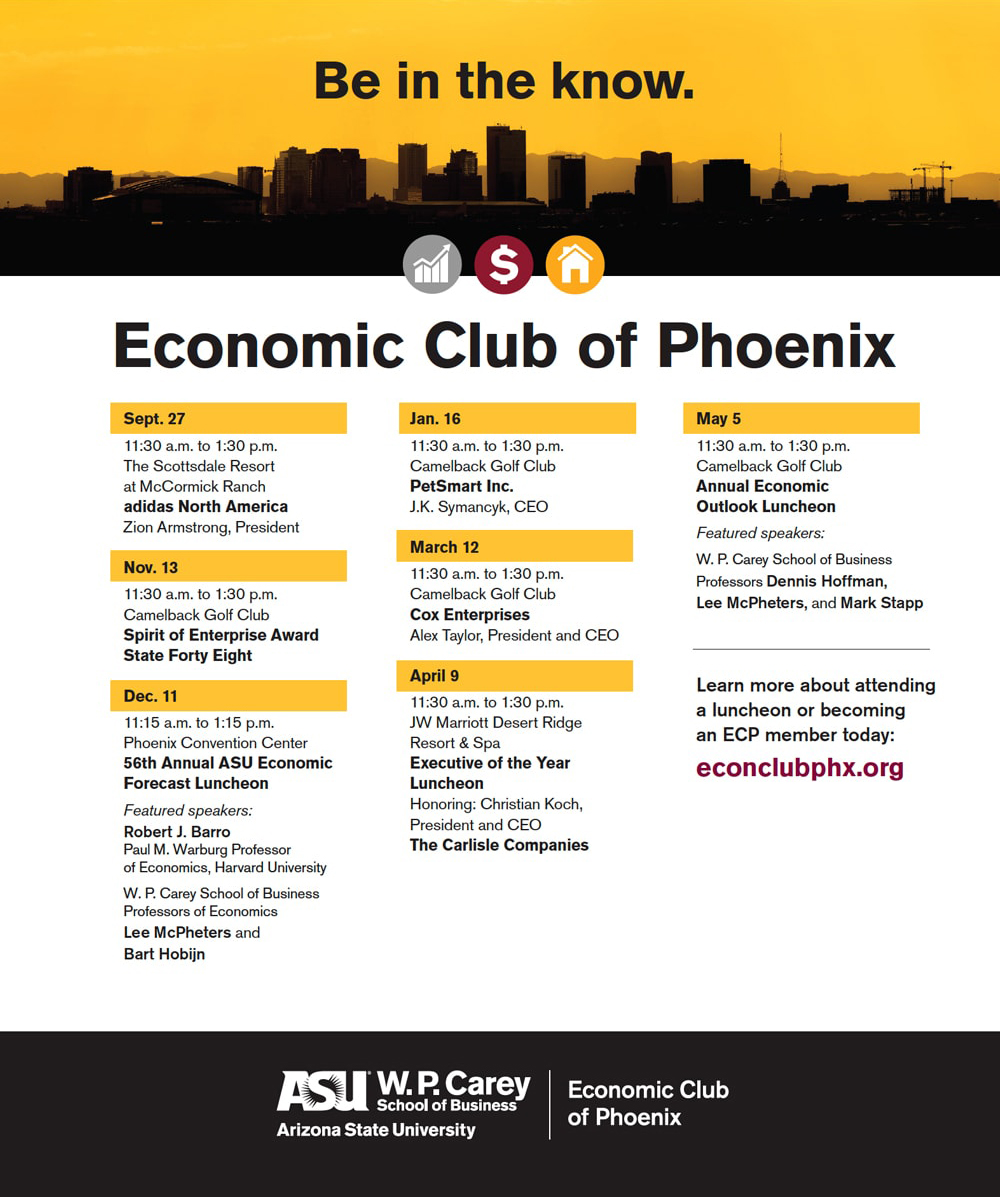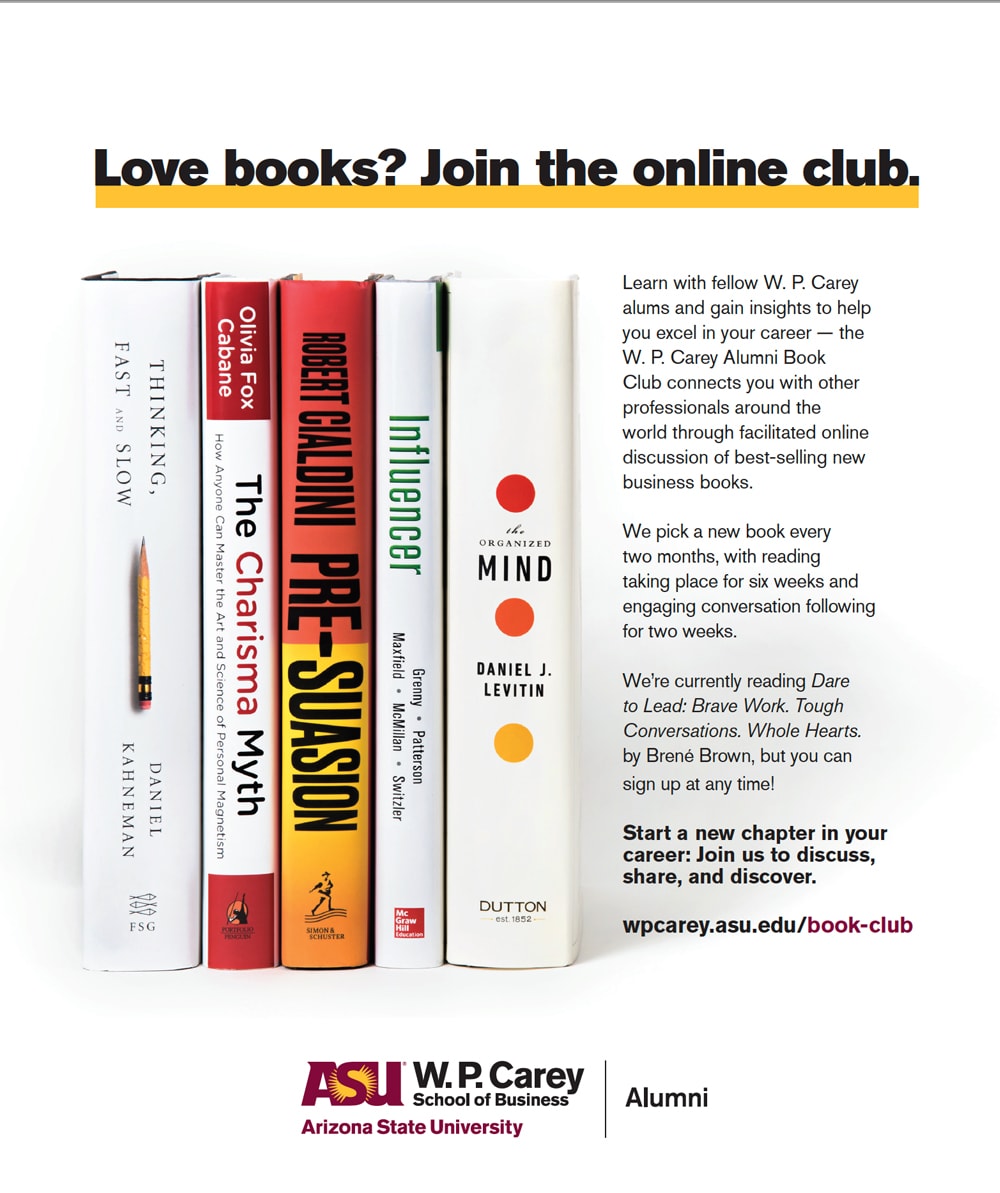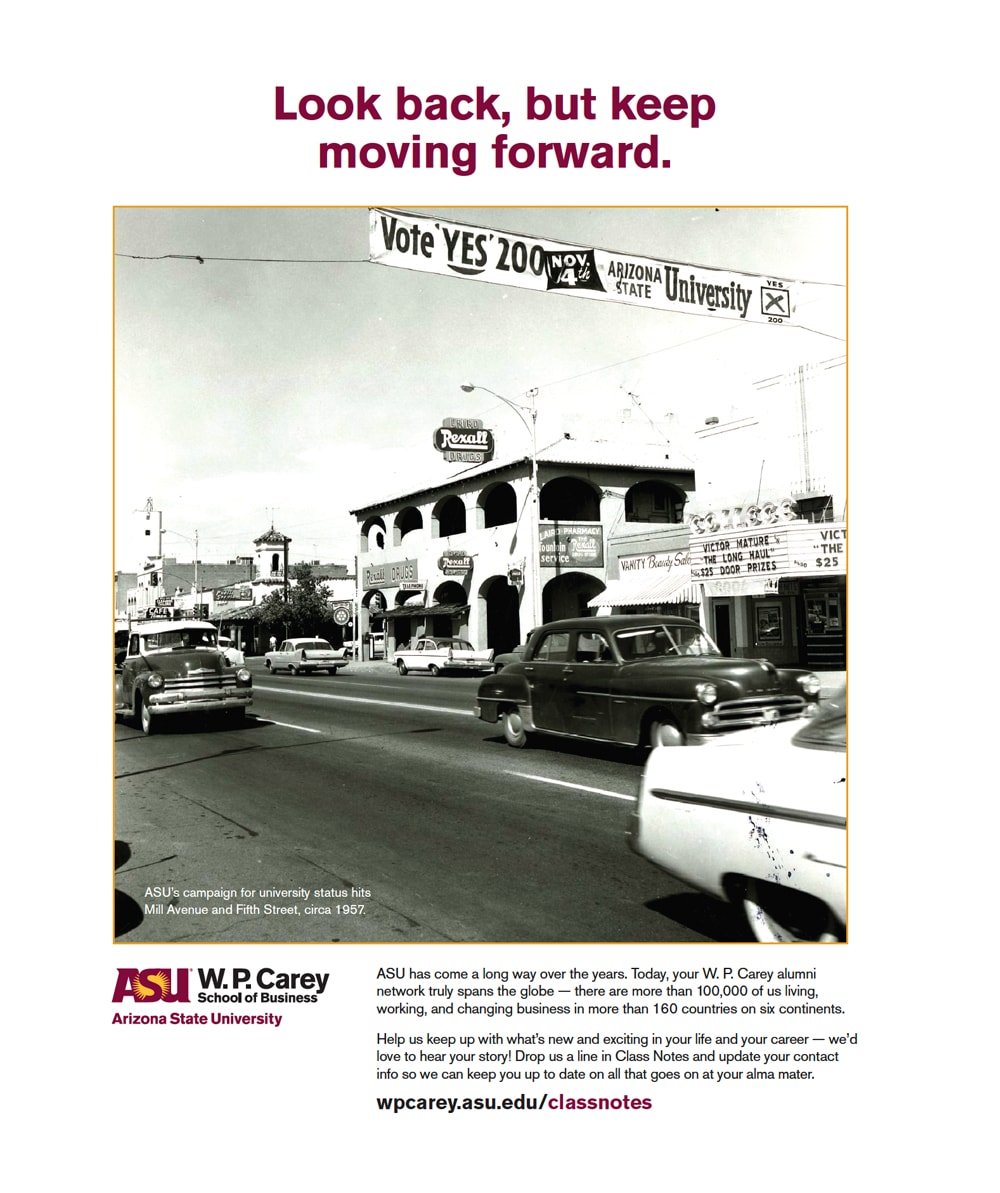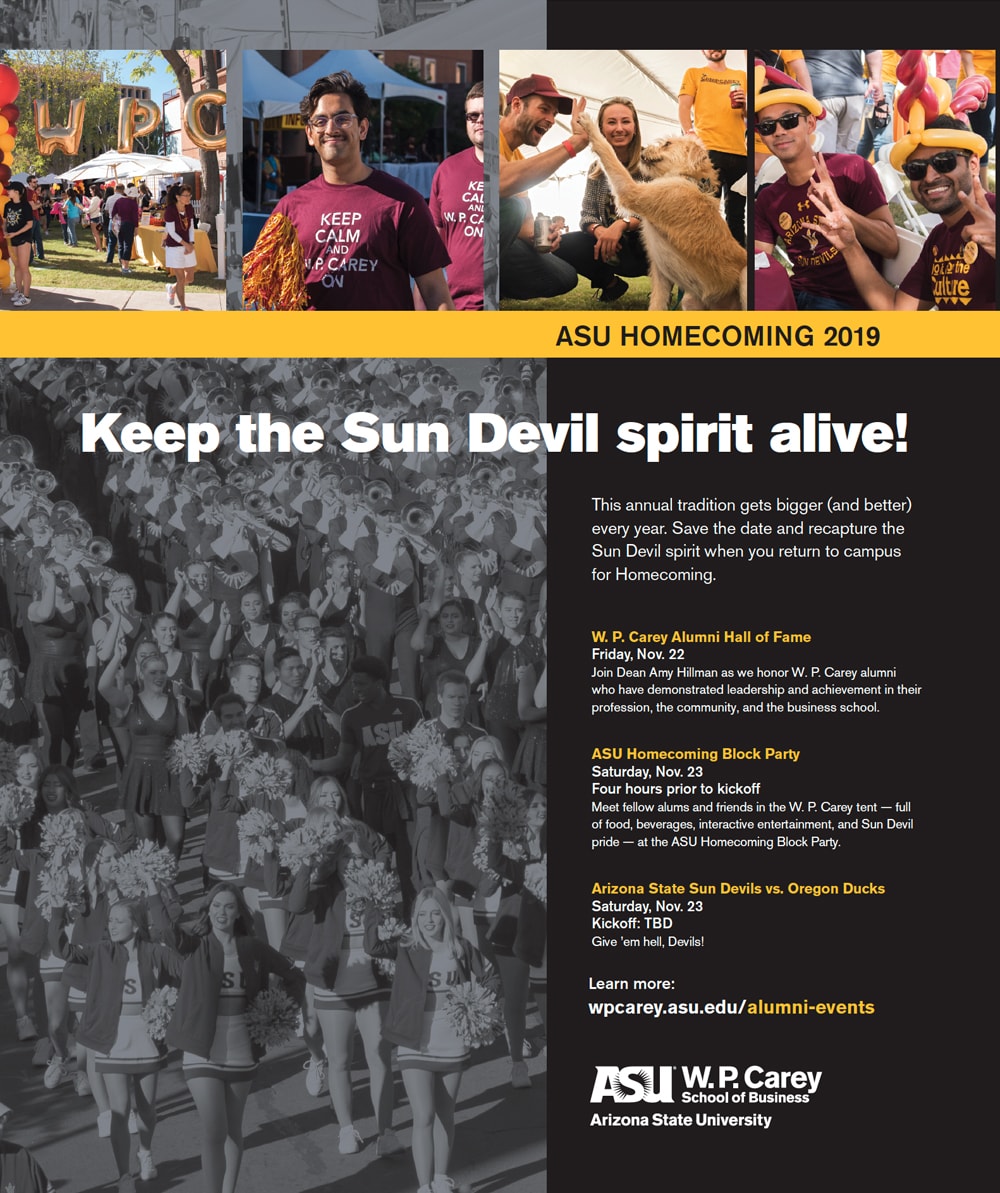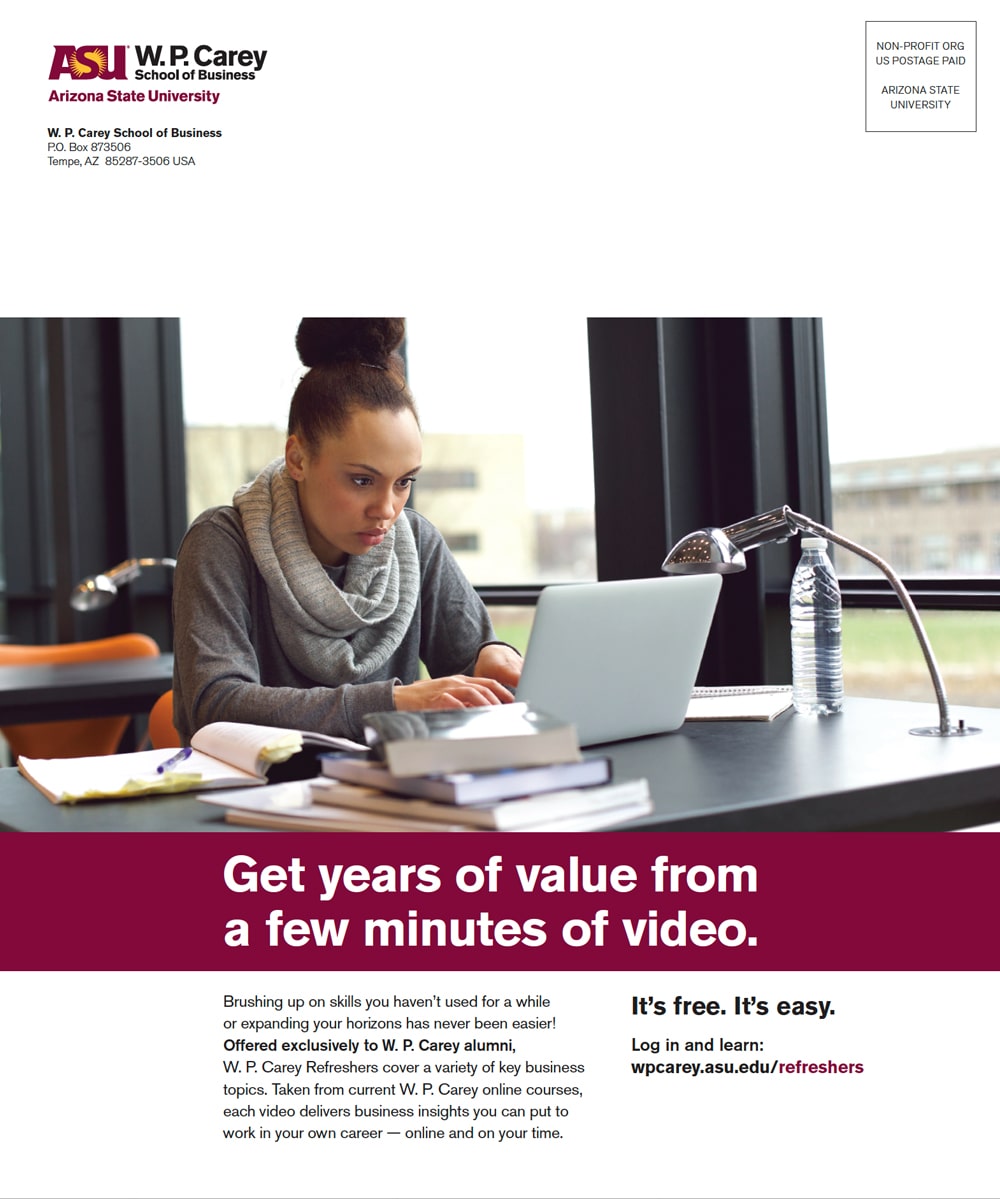
— Marilyn Monroe
Both ASU and the W. P. Carey School of Business have a long history of providing lifelong learning opportunities.
For more than 30 years, we’ve learned from top corporate executives about how to lead at the Economic Club of Phoenix luncheons. In addition to our degree programs, we offer continuing education courses, free digital courses on hot topics for our alumni (e.g., digital marketing, and soon to come is fintech), massive open online courses (MOOCs) available for free or reduced tuition that equate to a “typical” freshman year at ASU, mini master’s degrees, certificates, and good old-fashioned lectures. 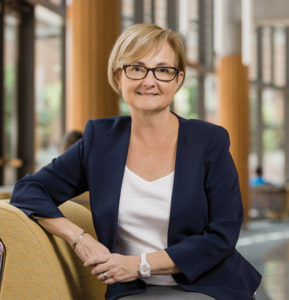
The rate of change in technology is making those of us who are employed lifelong learners — or else we fall behind. I’ve told you about our mentoring programs, but have you ever considered what a student could do as a reverse mentor to you? For example, they’re quite good at social media; if I’m having trouble, I just walk out on the Dean’s Patio and anyone can help. Soon, ASU will have a vibrant senior living community called Mirabella at the corner of University and Mill in Tempe, where the residents will have full access to ASU and all of its lifelong learning opportunities. We’re focused on how we can develop mentoring between the residents and our students, and I’m sure some reverse mentoring will happen as well.
I shared with you some time ago that I was learning Mandarin. It’s been fun to learn something “just for fun,” although, I have to confess, I’m not making much progress. But I know there’s value in simply learning. Doctors tell us this keeps our brains active as we age, no matter what the subject. If we were to offer a class, lecture, webcast, etc., what would you most want to learn with us? Email me at amy.hillman@asu.edu to let me know.
Here’s to all the learners out there! Never stop.
Warm regards,
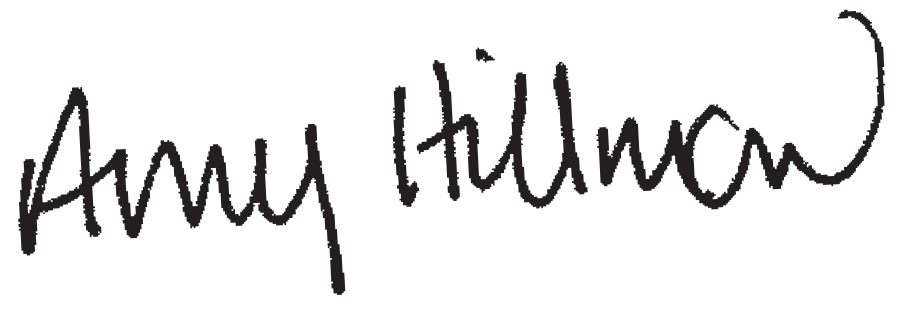
— Marilyn Monroe
Both ASU and the W. P. Carey School of Business have a long history of providing lifelong learning opportunities.
For more than 30 years, we’ve learned from top corporate executives about how to lead at the Economic Club of Phoenix luncheons. In addition to our degree programs, we offer continuing education courses, free digital courses on hot topics for our alumni (e.g., digital marketing, and soon to come is fintech), massive open online courses (MOOCs) available for free or reduced tuition that equate to a “typical” freshman year at ASU, mini master’s degrees, certificates, and good old-fashioned lectures.
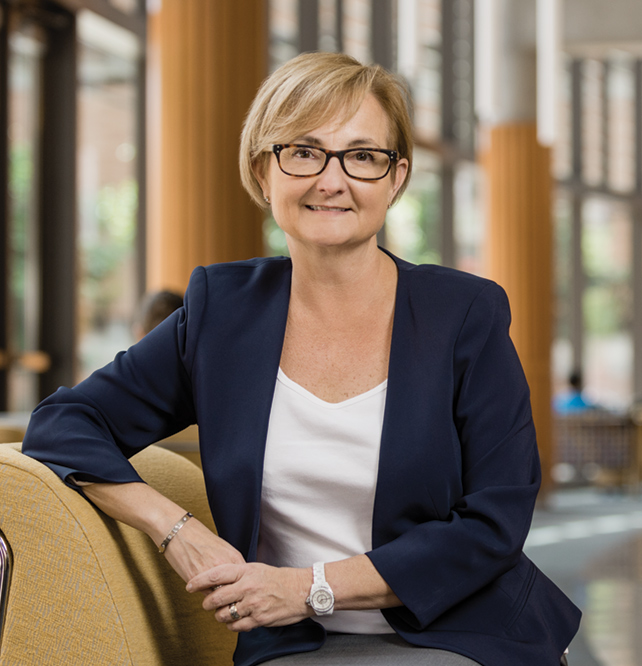
I shared with you some time ago that I was learning Mandarin. It’s been fun to learn something “just for fun,” although, I have to confess, I’m not making much progress. But I know there’s value in simply learning. Doctors tell us this keeps our brains active as we age, no matter what the subject. If we were to offer a class, lecture, webcast, etc., what would you most want to learn with us? Email me at amy.hillman@asu.edu to let me know.
Here’s to all the learners out there! Never stop.
Warm regards,

I was pleased to read about the 50th anniversary of the BA building. I was an undergraduate student at the time of the opening of the BA building. One of the most popular attributes at the time was the computer room located near the center staircase on the first floor. There was a large room with an exterior glass wall that contained an IBM business computer. (This is most likely why the color blue was used for the first floor.) The computer printer was located near the exterior glass wall so students could see and hear it from the outside. This computer room was very unique for the time. I hope that it is mentioned in the next BA building anniversary article.
In the ’60s, most of the math was done with pencil and paper. There were calculators in a BA room, and they were the size of typewriters. We did not have handheld calculators.
John W. Overland (BS Management ’72)
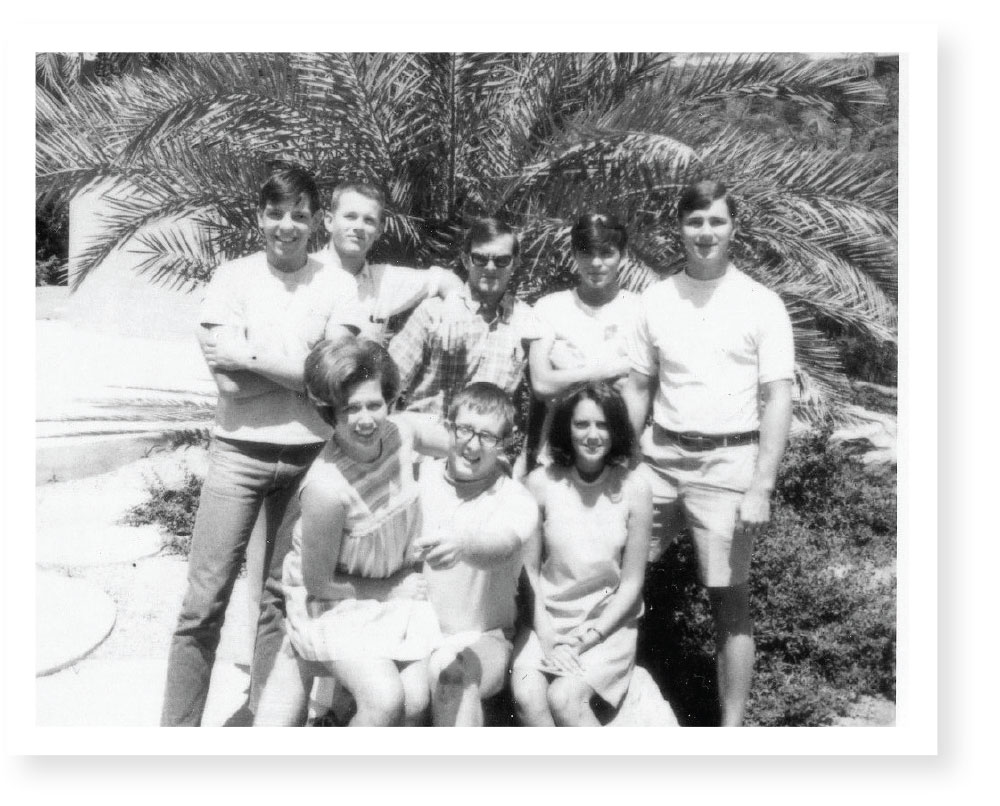
Thank you for the recent article about the Business Administration building’s 50th anniversary.
I was lucky to be among some of the first students to get to use the new building during the second summer session of 1968 before the official dedication. I had a business communications class taught by Dr. John Toodle, and also a management class. I thought it was a beautiful building then, and I still do.
That was a special summer for me. While standing in line to pay my dorm fee, I met a pretty geology student. Next year, that pretty girl and I will be celebrating our 50th wedding anniversary.
Vic Wickersham (MBA ’72)

Volume 7, Issue 1, Autumn 2019
Dean
Amy Hillman
Chief External Relations Officer
Kim Steinmetz
Director of Alumni Relations
Brennan Forss
Manager of Alumni Relations
Theresa Shaw
W. P. Carey Alumni
wpcarey.asu.edu/alumni
Facebook
facebook.com/wpcareyschool
LinkedIn
wpcarey.asu.edu/linkedin
Twitter
@WPCareySchool
Shay Moser
Creative Director
Paula Murray
Art Director
David Imes
Staff Contributors
Emily Beach, Colin Boyd, Perri Collins, Mary Beth Faller, Carson Kamp, Hannah O’Regan, Scott Seckel, Samantha Sloman
Contributors
Joe Bardin, Kim Catley, Andrew Clark, Claire Curry, Jane Larson, Erin Peterson, David Schwartz, Jenn Woolson
Photographers
Tina Celle, Mark Lipczynski, W. Scott Mitchell, Shelley Valdez
Managing Editor
W. P. Carey School of Business
Arizona State University
PO Box 872506
Tempe, AZ 85287-2506
Changes of address and other subscription inquiries can be emailed to:
editor.wpcmagazine@asu.edu
W. P. Carey magazine is a publication of the W. P. Carey School of Business at Arizona State University © 2019
Send editorial submissions and letters to:
editor.wpcmagazine@asu.edu

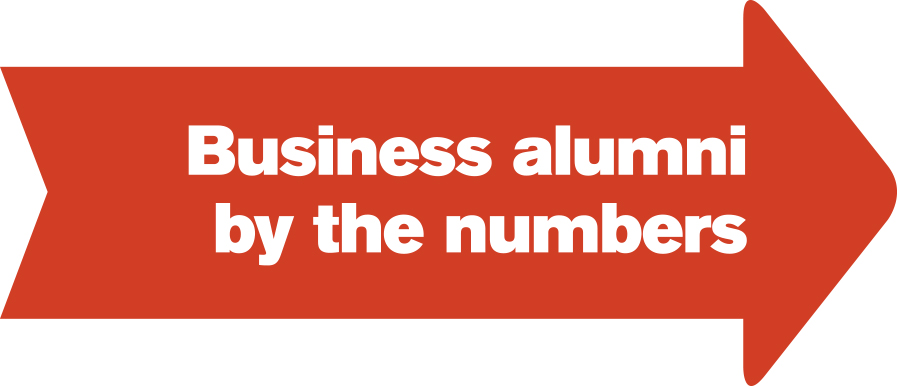

Grand Canyon — over 18 miles! Your alumni community is 100,000+ strong.

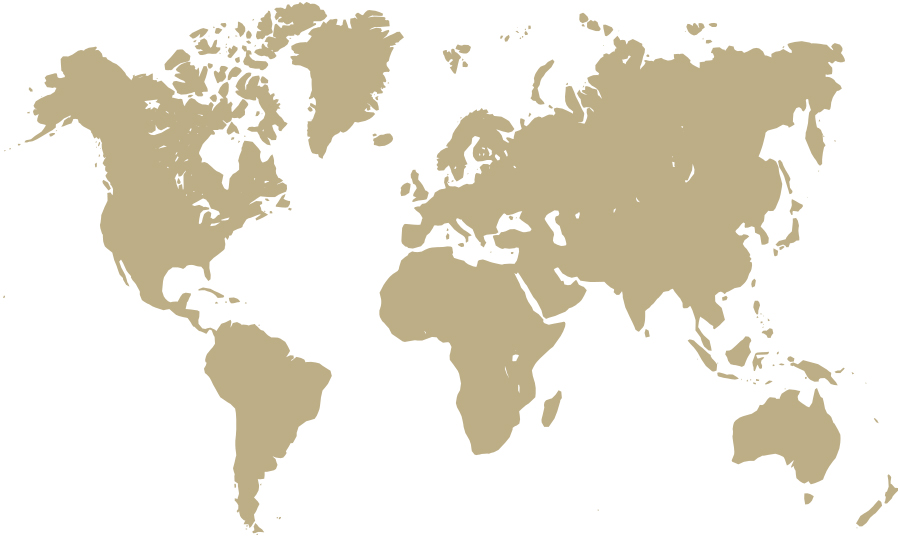
2. China
3. India
4. Canada
5. Mexico
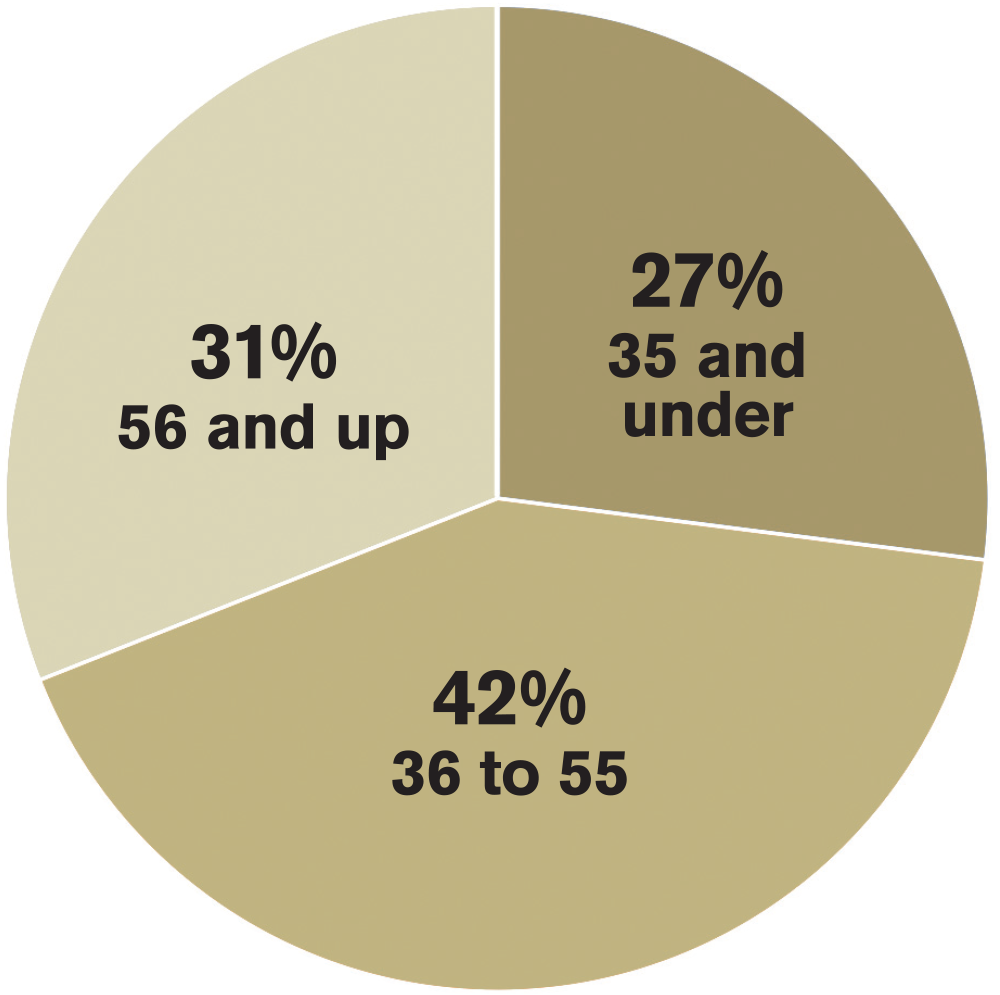
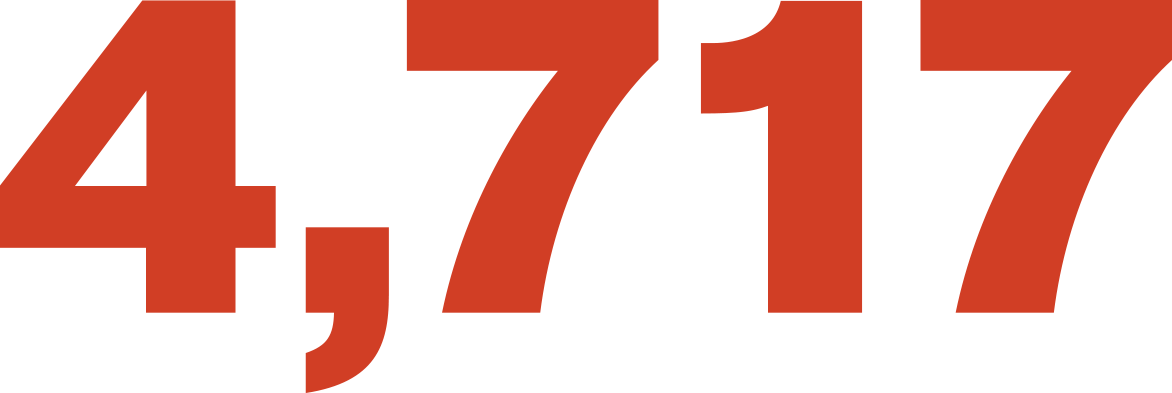
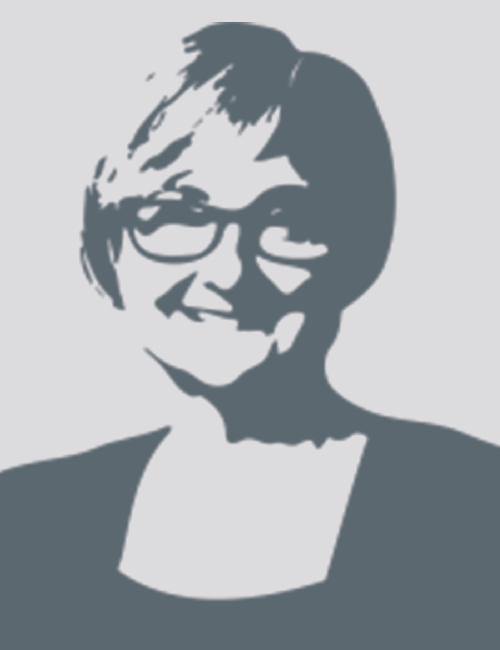
She doesn’t like to toot her horn, so we’ll do it for her. Dean Amy Hillman has been elected by the membership of the Academy of Management (AOM) — the premier international organization for faculty of management, with more than 20,000 members — to serve as vice president-elect/program chair-elect of the AOM for a five-year leadership cycle that will culminate in the role of president in 2024.
“I am honored to have been elected by my peers within the academy for this leadership role,” says Hillman. “As an active member of AOM for over 20 years, I have served in a variety of roles within the organization, and I am thrilled to have the opportunity to impact the profession in this way. I truly look forward to the next five years.”
Way to go, Amy!
She doesn’t like to toot her horn, so we’ll do it for her. Dean Amy Hillman has been elected by the membership of the Academy of Management (AOM) — the premier international organization for faculty of management, with more than 20,000 members — to serve as vice president-elect/program chair-elect of the AOM for a five-year leadership cycle that will culminate in the role of president in 2024.
“I am honored to have been elected by my peers within the academy for this leadership role,” says Hillman. “As an active member of AOM for over 20 years, I have served in a variety of roles within the organization, and I am thrilled to have the opportunity to impact the profession in this way. I truly look forward to the next five years.”
Way to go, Amy!

All Things WPC
new agribusiness class made a real splash this spring.
“We wanted to do something different,” says Marvin and June Morrison Chair in Agribusiness Tim Richards. “So we’re teaching ‘vertical’ — everything about an industry from the ground up — and we wanted to choose an industry that would be attractive to students.”
Turns out the business of beer is plenty attractive.
Taught by Richards and fellow Morrison School of Agribusiness faculty Carola Grebitus, the first class of Agribusiness 494 students learned about price elasticity and regression analysis. They also heard about hops farms, spontaneous fermentation, and how issues like labor costs work in real life, thanks to local beer industry leaders including ASU alumnus Patrick Ware.
shared drive to harness the power of sport to deliver real-world solutions is at the heart of ASU’s partnership with adidas. The Global Sport Alliance leverages education, athletics, research, and innovation — including ideas and initiatives led by the Global Sport Institute and its CEO, adidas Distinguished Professor of Global Sport Ken Shropshire — to change lives through sport.
An expert in sports business, sports law, and the social impact of sport, Shropshire holds faculty appointments at multiple colleges within ASU, including its top-ranked W. P. Carey School of Business. “In the end, we want to provide greater access to information involving sport, in a way that people can understand,” he says. “There are really no boundaries to where the Global Sport Institute might go.”
Each year, the institute aligns its research, events, and other work with an annual theme. For 2017–18, Sport 2036 aimed to “shape a progressive vision for what sport could and should look like in the future.”
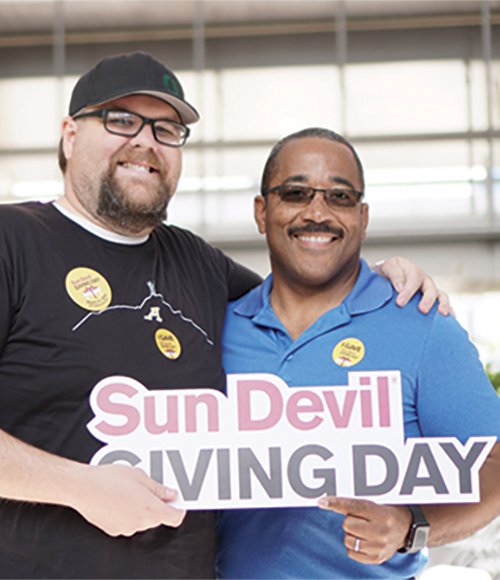
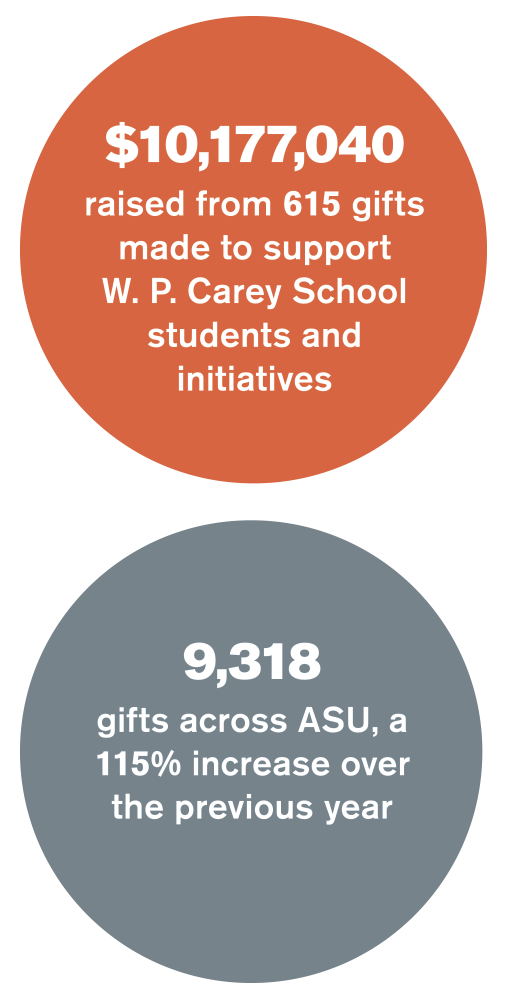
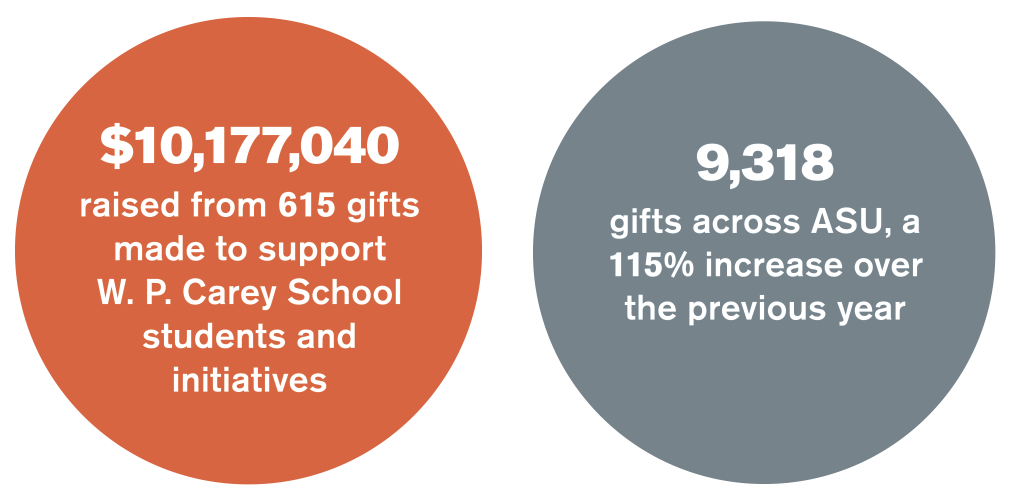
ore than 9,000 students, staff, alumni, faculty, and friends banded together to make ASU’s annual day of giving one for the ages. This year’s Sun Devil Giving Day broke multiple records, all for a good cause — generating a combined $11.4 million to fuel scholarships, innovation, emerging programs, student success, and more.
- $25 was the median size of gift this year
- 79% of gifts were $100 or less
alker McCrae (BS Business Data Analytics/BA Sports Business ’19) grew up in Portland, thinking he would one day attend the University of Oregon. His desire to study sports business, however, attracted his attention to ASU.“I chose ASU for its sports business program and because of its location relative to other sports entities,” McCrae says. “I had always wanted to attend the University of Oregon but after touring there, I realized its remote location would make it difficult to find experience in the sports world.”
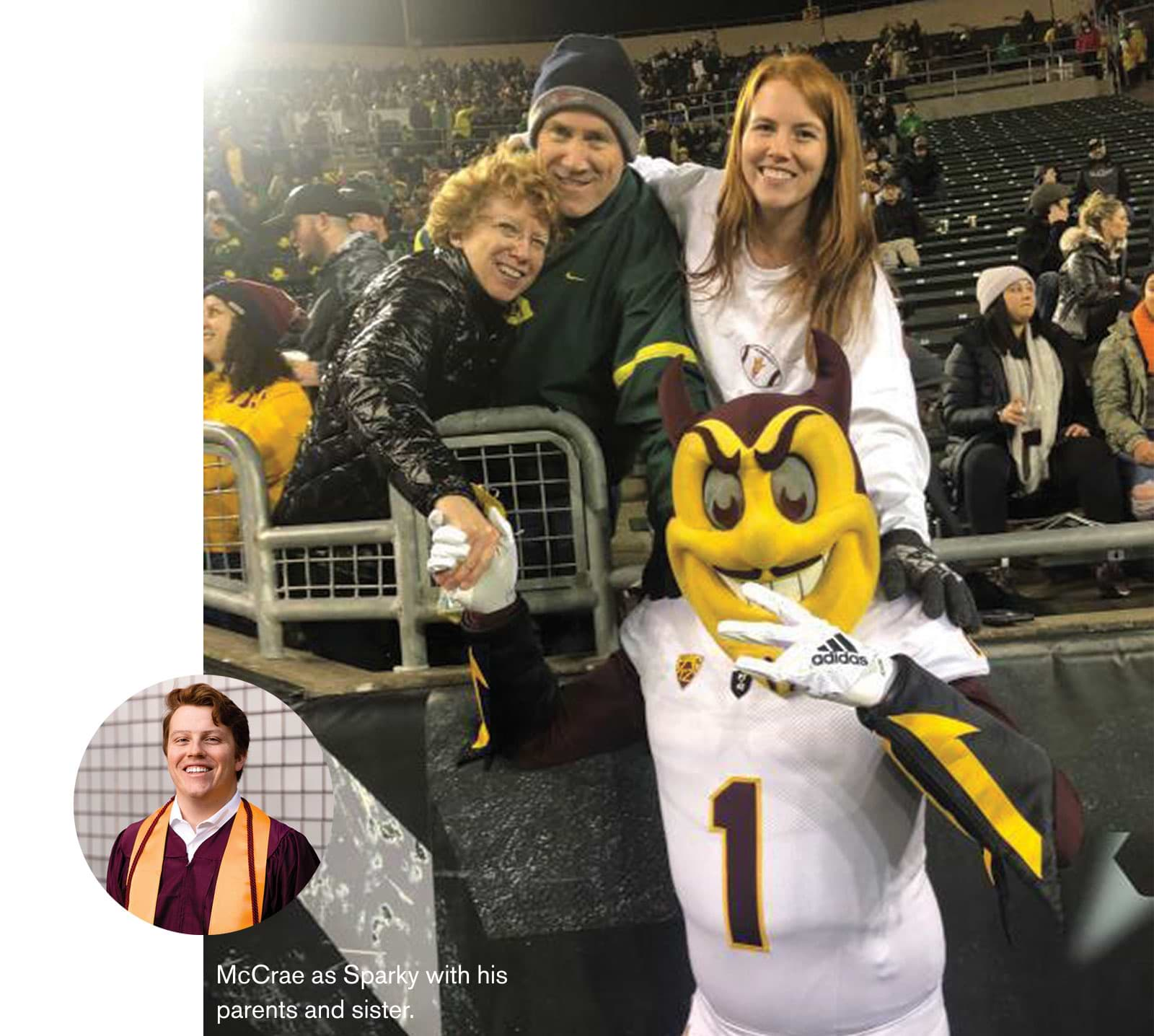
alker McCrae (BS Business Data Analytics/BA Sports Business ’19) grew up in Portland, thinking he would one day attend the University of Oregon. His desire to study sports business, however, attracted his attention to ASU.
“I chose ASU for its sports business program and because of its location relative to other sports entities,” McCrae says. “I had always wanted to attend the University of Oregon but after touring there, I realized its remote location would make it difficult to find experience in the sports world.”
he Sustainability Consortium (TSC) was created in 2009, with a mission to transform the consumer goods industry. Now, in partnership with its more than 100 members — including top companies, NGOs, universities, and government organizations — TSC helps organizations define, develop, and deliver more sustainable products.
An engine for ingenuity
Over the past six years or so, TSC has built a science-based system to enable the above and more. Covering everything from adhesive tapes and toys to root vegetables and refrigerators, the group offers companies access to research insights on nearly 130 product categories, along with the opportunity to work with competitors without the competition.
“By sharing sustainability measurement tools with large, well-known brands at the hub of the $14 trillion global economy, we’re on an exciting track to influence social and environmental stewardship involving $1 trillion of consumer sales,” says Chief Scientist Kevin J. Dooley, ASU Distinguished Professor of Supply Chain Management.
Well-known brands engaged with TSC include Walmart, Amazon, Walgreens, and Sprouts Farmers Market, to name a few. “TSC proves that universities are good places for the world to bring difficult and controversial issues to,” Dooley says, “[…] as a safe and objective place for deliberation and discourse, even for groups that are very far apart from each other.”
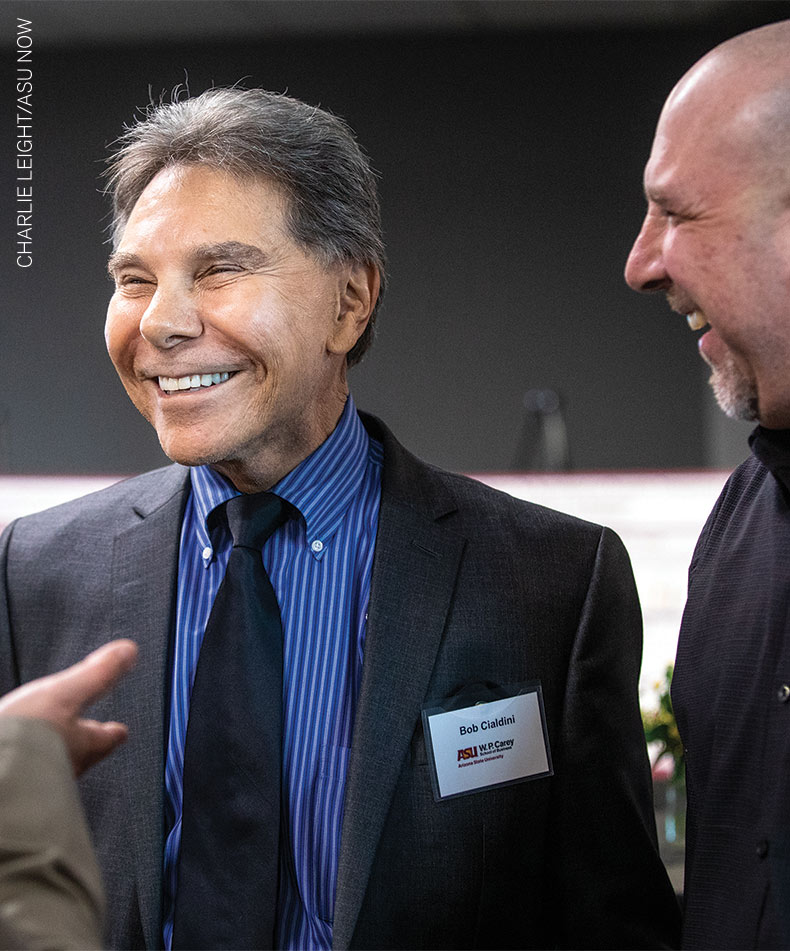
his bright idea comes from “Pre-Suasion: A Revolutionary Way to Influence and Persuade,” the latest book by Regents’ Professor Emeritus of Psychology and Marketing Robert Cialdini.
We are pleased to announce that Cialdini was recently elected a member of the National Academy of Sciences, one of the country’s most distinguished scientific organizations. Frequently regarded as the “Godfather of Influence,” he is known and respected worldwide for his body of work.
first-of-its-kind partnership between ASU and Starbucks, the Starbucks College Achievement Plan (SCAP) creates an opportunity for all eligible Starbucks employees to earn their bachelor’s degrees through ASU Online with full tuition coverage. Tapped to develop a future-forward business degree for emerging retail leaders, the W. P. Carey School’s online bachelor’s in retail management was launched along with the Starbucks partnership in 2014.
Today, retail management is only one of the business degrees that Starbucks employees can pursue at ASU. Learn more: starbucks.asu.edu
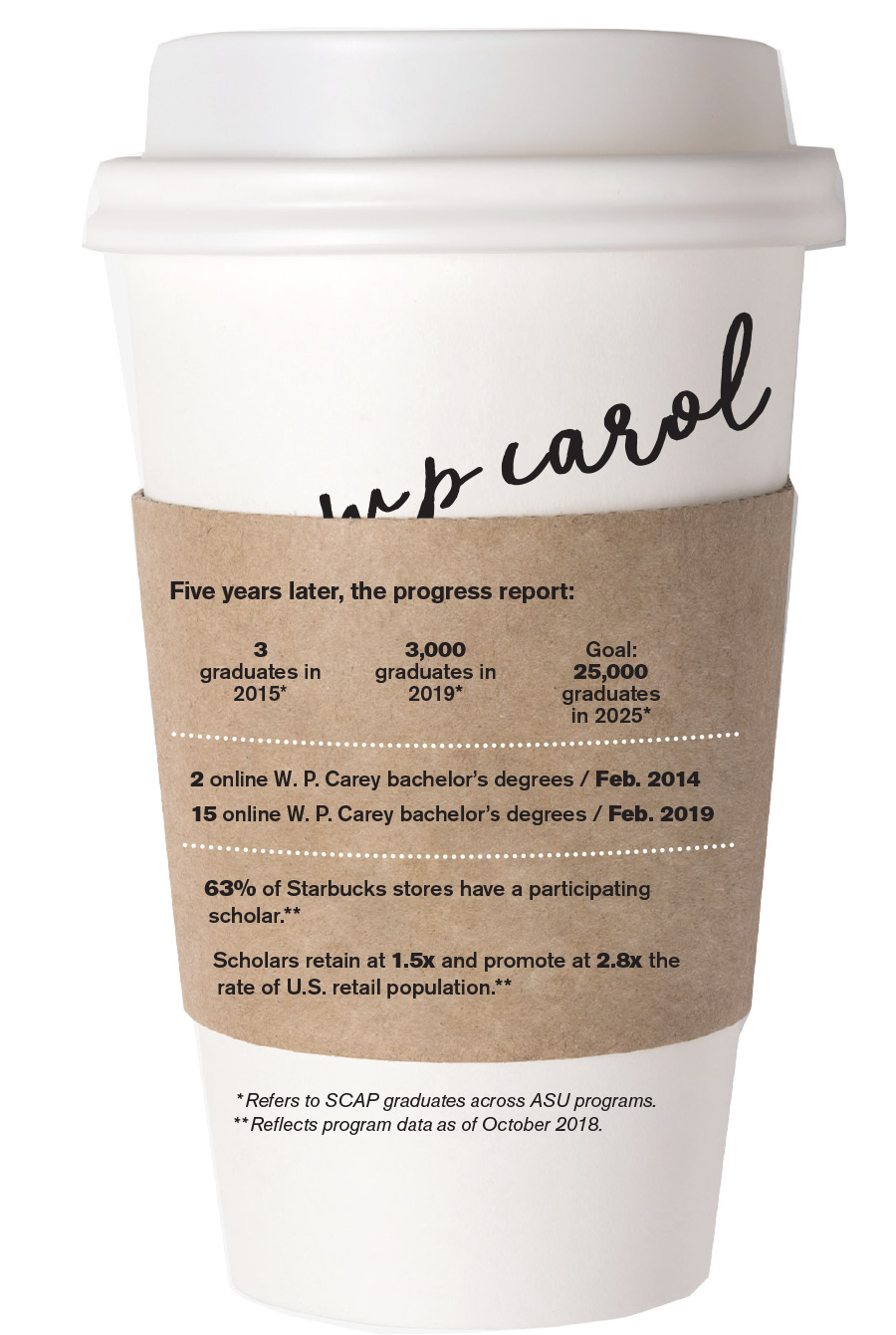
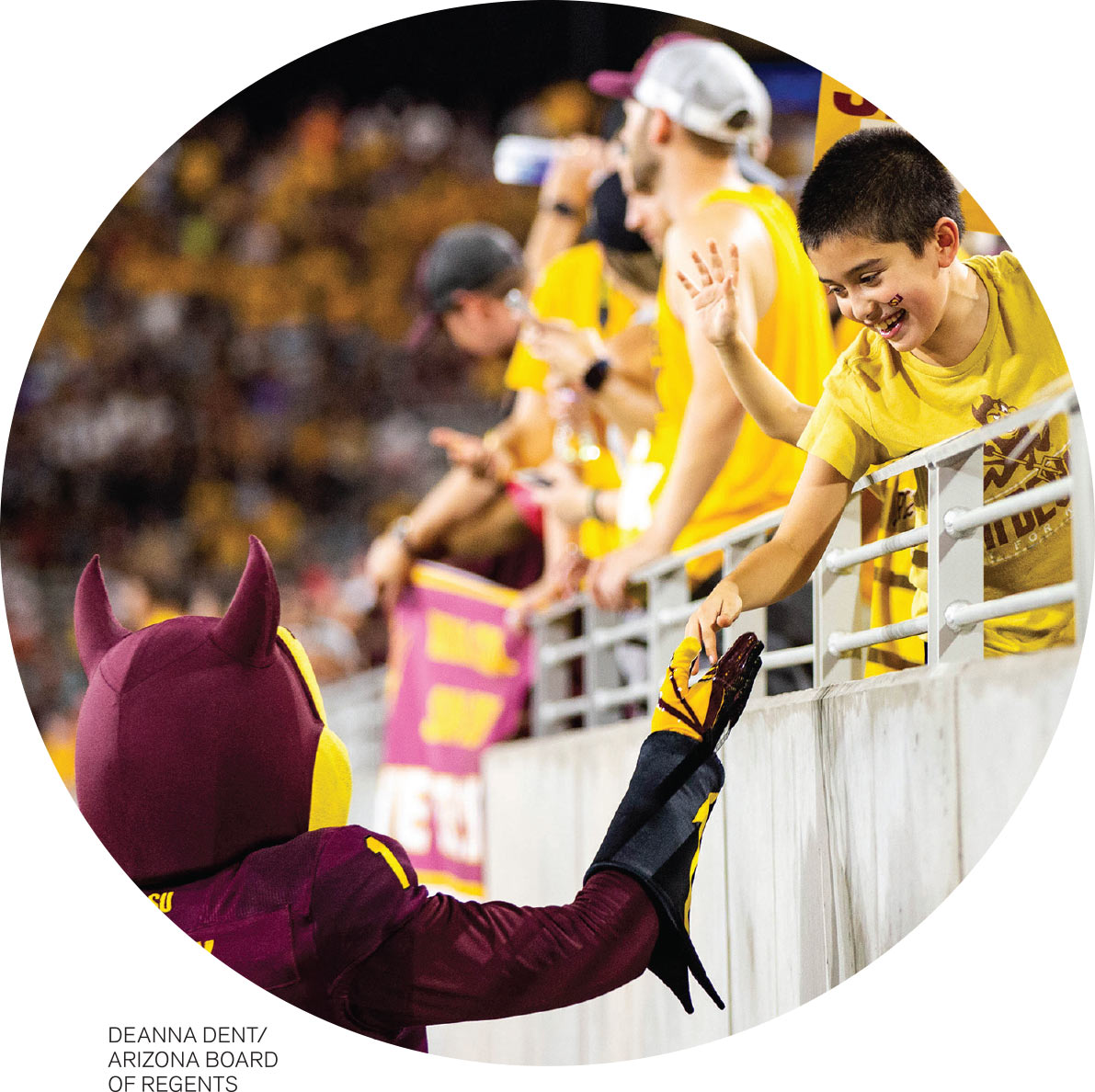

SEPT. 27
2019
The Economic Club of Phoenix season kicks off with keynote speaker Zion Armstrong, president of adidas North America. wpcarey.asu.edu/ecp
OCT. 16
2019
Lawrence R. Klein Award for Blue Chip Forecast Accuracy
Hosted in New York City, the Klein Award is presented annually to recognize consistency and accuracy in economic forecasting. wpcarey.asu.edu/klein
NOV. 13
2019
ECP presents its annual Spirit of Enterprise Award to Arizona-based clothing company State Forty Eight. wpcarey.asu.edu/ecp
NOV. 22
2019
The annual ceremony welcoming new alums to our prestigious Hall of Fame will be held just before Homecoming. wpcarey.asu.edu/fame
NOV. 23
2019
Join us in the W. P. Carey tent at ASU’s annual block party for food, fun, and an adult beverage with friends before the game. homecoming.asu.edu
DEC. 11
2019
Hear top national and regional experts present their economic forecasts and advice. wpcarey.asu.edu/efl
Explore opportunities to engage with fellow alumni and your alma mater: wpcarey.asu.edu/calendar
DEC. 11
2019
Hear top national and regional experts present their economic forecasts and advice. wpcarey.asu.edu/efl
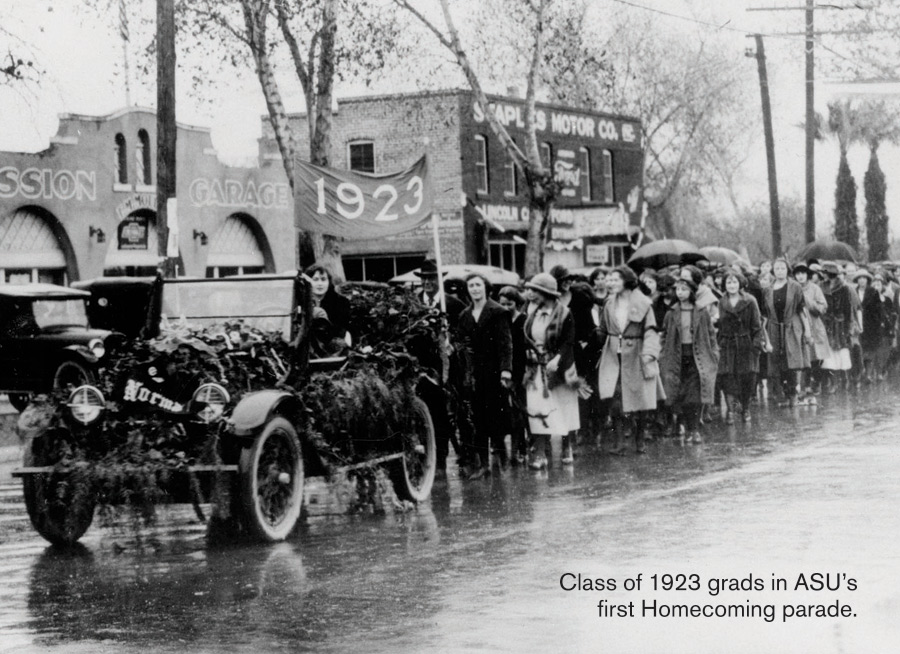

Legacy: Since then, The Lund Team has worked with thousands of clients and participated in more than $2 billion in residential real estate transactions.
Still, that may not be Lund’s primary claim to fame.
He may be best known for installing “kindness meters” in Carlsbad, California, that look like regular parking meters but are designed to encourage charitable giving. “When people look back, I want to be known for being kind — that’s what I want my historical relevance to be,” he says.
Background: “I may have been born in Wisconsin, but once I moved to California there was no going back. I love Carlsbad,” he says.
Beyond his ventures in real estate, that love has translated into several passion projects for the town and its residents, including developing a Legoland and the resurrection of the iconic Carlsbad sign. In an effort to make Carlsbad “America’s Kindest City,” Lund embarked on a journey to install eight smart parking meters throughout the town to collect money for local charities.
Lund’s solar-powered meters can collect loose change or bigger donations with a credit card. All proceeds support several local charities.
Stats: The installation of the Carlsbad sign, which stretches 82 feet across historic Highway 101 and the Carlsbad Village Drive intersection and lights up at night, took years of advocacy on the part of Lund. Kindness meters installed nearby help pay for the sign’s maintenance and electricity.
Lesson: “My experience at ASU was so valuable,” Lund says. “I learned that as long as I worked hard, I could enjoy and live life to the fullest. It was an excellent school.”
Recommendation: “It’s important for you to give back to your communities,” Lund says. “It’s important that you be the best that you can be and that you bring light, respect, love, and kindness to people. We live in an extraordinary time — unlike any in my life — and we need kindness more than ever.”



Brief: Credit Carlton Lund (MBA ’71) with creative ambition like few others. Before founding his North San Diego real estate company with his wife, Sandy, in 1982, Lund got his pilot’s license with the idea that it would give him a leg up on his competitors. “I wanted to get in the air to look at the land,” he says. “I thought it would give me an idea of the best properties in the area.”
Legacy: Since then, The Lund Team has worked with thousands of clients and participated in more than $2 billion in residential real estate transactions.
Still, that may not be Lund’s primary claim to fame.
He may be best known for installing “kindness meters” in Carlsbad, California, that look like regular parking meters but are designed to encourage charitable giving. “When people look back, I want to be known for being kind — that’s what I want my historical relevance to be,” he says.
Background: “I may have been born in Wisconsin, but once I moved to California there was no going back. I love Carlsbad,” he says.
Beyond his ventures in real estate, that love has translated into several passion projects for the town and its residents, including developing a Legoland and the resurrection of the iconic Carlsbad sign. In an effort to make Carlsbad “America’s Kindest City,” Lund embarked on a journey to install eight smart parking meters throughout the town to collect money for local charities.
Lund’s solar-powered meters can collect loose change or bigger donations with a credit card. All proceeds support several local charities.
Stats: The installation of the Carlsbad sign, which stretches 82 feet across historic Highway 101 and the Carlsbad Village Drive intersection and lights up at night, took years of advocacy on the part of Lund. Kindness meters installed nearby help pay for the sign’s maintenance and electricity.
Lesson: “My experience at ASU was so valuable,” Lund says. “I learned that as long as I worked hard, I could enjoy and live life to the fullest. It was an excellent school.”
Recommendation: “It’s important for you to give back to your communities,” Lund says. “It’s important that you be the best that you can be and that you bring light, respect, love, and kindness to people. We live in an extraordinary time — unlike any in my life — and we need kindness more than ever.”

Executive
Full-time
Online
Professional Flex
MBA
Business Analytics
Supply Chain Management
Accountancy
Accountancy – Data and Analytics
Business Analytics
Finance
Global Logistics
Information Management
Real Estate Development
Supply Chain Management
Taxation

rules of
retail

ore and more online retailers are incorporating flash sales into their business and marketing strategies, generating consumer excitement by offering a great deal at a low price for a limited time until the supply runs out. For example, since 2015, Amazon’s most successful single day is its record-breaking Prime Day, selling millions of products totaling more than $1 billion in flash sales.
This increasingly popular selling strategy led Professor of Supply Chain Management Elliott Rabinovich and Annibal Sodero of the University of Arkansas to wonder how retailers can better manage flash sales, and compete with the likes of Amazon, even when they’re smaller and may not have access to cutting-edge predictive analytics.
Their study, titled “Demand and Revenue Management of Deteriorating Inventory on the Internet: An Empirical Study of Flash Sales Markets (FSM),” appeared in the Journal of Business Logistics and reports many interesting findings.
The supply and demand seesaw
For retailers, the flash environment requires a unique balancing act between supply and demand. When the price is set too low, the product can sell out too quickly, disappointing and even upsetting customers, potentially damaging the brand. On the other hand, if the price is set too high, not enough product gets sold within the allotted time frame, and the company can incur losses on overstocking.
aby boomer John Goodman remembers his first major purchase with remarkable detail, despite his parents placing the order for him in the 1950s.
Ordered through a print catalog, his coveted tennis shoes arrived via the postal carrier and were stuffed into the mailbox. He went running later that same day with the newly acquired merchandise.
“Before, you would get a catalog that you had put away in a drawer, look through it, and order what you wanted or needed at the time,” says Goodman (BS Business Administration/Accounting ’67). “Now you do the same thing, but you do it online.
“That’s the catalog of today,” adds Goodman, 73, a highly decorated, retired U.S. Marine Corps three-star general and former ASU quarterback. “The only thing that’s really changed is the vehicle for doing it.”
No more Sears, Roebuck and Co. and J.C. Penney catalogs of yesteryear: Amazon and others have found a solid place in the hearts and minds of shoppers across a wide swath of generations. But by no means is the brick-and-mortar store ready to be buried in concrete yet, according to a new research study by Salesforce.

rofessor of Marketing Ruth Bolton’s research paper, “Customer Experience Challenges: Bringing Together the Digital, Physical, and Social Realms,” didn’t exactly start on the back of a cocktail napkin, but the story isn’t far off.
While at a future-focused conference in Australia, she and some of her fellow attendees were so excited by the ideas being presented that they met and conceived the idea for the paper on the spot. “We started talking, and the paper unfolded very rapidly,” Bolton says. “People were throwing ideas out and pulling things up on the internet.”
They found that these three areas — the digital, physical, and social — are being studied and implemented in isolation, creating a fragmented customer experience. New technologies, such as artificial intelligence, robots, and virtual reality, are changing the way businesses interact with customers. But it’s how effectively they integrate these new methods of engaging customers with existing face-to-face interactions that will determine their success.
“Capabilities are rushing ahead without us really knowing much about what will make a good customer experience,” Bolton explains, and most companies aren’t yet able to connect the dots. For example, if you shop online, the merchant doesn’t necessarily know you’re the same person who was in their store yesterday. Or, if you walk into the store and you’ve already done some research online, they don’t know that. If you’re shopping with a friend, but their immersive experience is just for one, the merchant is missing out on the social element. In this new world, managers will need to understand customer experiences across all three spaces.
That’s where business experts are taking the baton from computer scientists. Instead of simply asking, “Can we do this?” marketers are looking at how the whole experience will affect the end user.
rofessor of Marketing Ruth Bolton’s research paper, “Customer Experience Challenges: Bringing Together the Digital, Physical, and Social Realms,” didn’t exactly start on the back of a cocktail napkin, but the story isn’t far off.
While at a future-focused conference in Australia, she and some of her fellow attendees were so excited by the ideas being presented that they met and conceived the idea for the paper on the spot. “We started talking, and the paper unfolded very rapidly,” Bolton says. “People were throwing ideas out and pulling things up on the internet.”
They found that these three areas — the digital, physical, and social — are being studied and implemented in isolation, creating a fragmented customer experience. New technologies, such as artificial intelligence, robots, and virtual reality, are changing the way businesses interact with customers. But it’s how effectively they integrate these new methods of engaging customers with existing face-to-face interactions that will determine their success.
“Capabilities are rushing ahead without us really knowing much about what will make a good customer experience,” Bolton explains, and most companies aren’t yet able to connect the dots. For example, if you shop online, the merchant doesn’t necessarily know you’re the same person who was in their store yesterday. Or, if you walk into the store and you’ve already done some research online, they don’t know that. If you’re shopping with a friend, but their immersive experience is just for one, the merchant is missing out on the social element. In this new world, managers will need to understand customer experiences across all three spaces.
That’s where business experts are taking the baton from computer scientists. Instead of simply asking, “Can we do this?” marketers are looking at how the whole experience will affect the end user.
irectors on the boards of public companies are expected to advise the CEO, monitor the quality of financial statements, and lend their expertise to making acquisitions successful. Especially sought-after for director positions are executives actively working at other companies because of the knowledge and networks they can bring to a board.
It’s a big job, and researchers have sometimes found that when directors get busy with other boards, at least one of the companies in whose boardrooms they sit can suffer.
Assistant Professor of Finance Luke Stein and W. P. Carey graduate Hong Zhao, now of the NEOMA Business School in France, knew most prior research focused on retirees, professionals, and others serving on multiple boards.
“Hong and I considered not only who’s a busy person … but the same person that’s busy sometimes, and sometimes they’re not,” Stein says. “Rather than think about who’s an effective director or who’s not, let’s take a given person and ask if there’s a difference between the times when that person is likely to do a good job and the times when that person is likely to do a bad job.”
In their paper published this year in the Journal of Corporate Finance, Stein and Zhao broke new ground by looking at the estimated one-third of directors who are full-time executives at other companies and by quantifying what happened when their employer’s poor performance distracted them from their part-time board duties.
The pair culled their data from a database of public firms between 1996 and 2016 and found 8,169 executives who served on other firms’ boards, for a total of 39,099 director years of service. For each director year, they calculated the stock performance of the director’s employer during the board firm’s fiscal year. When employer firms performed in the bottom quintile, the researchers found the executives were more likely to miss board of directors meetings. Because directors do much of their monitoring and advising at these meetings, the researchers used meeting attendance to measure distraction.
irectors on the boards of public companies are expected to advise the CEO, monitor the quality of financial statements, and lend their expertise to making acquisitions successful. Especially sought-after for director positions are executives actively working at other companies because of the knowledge and networks they can bring to a board.
It’s a big job, and researchers have sometimes found that when directors get busy with other boards, at least one of the companies in whose boardrooms they sit can suffer.
Assistant Professor of Finance Luke Stein and W. P. Carey graduate Hong Zhao, now of the NEOMA Business School in France, knew most prior research focused on retirees, professionals, and others serving on multiple boards.
“Hong and I considered not only who’s a busy person … but the same person that’s busy sometimes, and sometimes they’re not,” Stein says. “Rather than think about who’s an effective director or who’s not, let’s take a given person and ask if there’s a difference between the times when that person is likely to do a good job and the times when that person is likely to do a bad job.”
In their paper published this year in the Journal of Corporate Finance, Stein and Zhao broke new ground by looking at the estimated one-third of directors who are full-time executives at other companies and by quantifying what happened when their employer’s poor performance distracted them from their part-time board duties.
The pair culled their data from a database of public firms between 1996 and 2016 and found 8,169 executives who served on other firms’ boards, for a total of 39,099 director years of service. For each director year, they calculated the stock performance of the director’s employer during the board firm’s fiscal year. When employer firms performed in the bottom quintile, the researchers found the executives were more likely to miss board of directors meetings. Because directors do much of their monitoring and advising at these meetings, the researchers used meeting attendance to measure distraction.
e hear a lot currently about student loans and the debt incurred to gain a higher education. Many argue that it places an undue burden on graduates as they seek to build their professional and financial futures. This has led to calls from some for more financial aid in the form of grants that don’t have to be repaid. But how effective are such grants?
Before this study, research had focused primarily on the effect of grants on college enrollments and the completion of coursework for degrees. But that is only one measure of the efficacy of grants for higher education. The larger question to be answered isn’t just whether students graduate, but how well they do, in real-life financial terms, after they graduate.
The desire to shed light on these issues led Professor of Economics Basit Zafar and his partner in the project, Judith Scott-Clayton of Teachers College at Columbia University, to conduct some groundbreaking research. Their study, “Financial Aid, Debt Management, and Socioeconomic Outcomes: Post-College Effects of Merit-Based Aid,” is the first to examine the impacts of grant aid on homeownership, neighborhood characteristics, and credit outcomes in early adulthood.
Accessing a unique data set
They were able to do this by examining college and financial aid information, and linking educational data to credit bureau data later in life. This unique confluence of data came about almost accidentally. Before joining ASU, Zafar served for more than eight years in the Research Group at the Federal Reserve Bank of New York. At the New York Fed, Zafar learned about the availability of information from the Equifax Credit Bureau on students who’d received grants. Zafar was able to conceive of this research because he knew of the availability of that data. Together with Scott-Clayton’s access to educational records from West Virginia, they were able to perform the necessary analysis.
e hear a lot currently about student loans and the debt incurred to gain a higher education. Many argue that it places an undue burden on graduates as they seek to build their professional and financial futures. This has led to calls from some for more financial aid in the form of grants that don’t have to be repaid. But how effective are such grants?
Before this study, research had focused primarily on the effect of grants on college enrollments and the completion of coursework for degrees. But that is only one measure of the efficacy of grants for higher education. The larger question to be answered isn’t just whether students graduate, but how well they do, in real-life financial terms, after they graduate.
The desire to shed light on these issues led Professor of Economics Basit Zafar and his partner in the project, Judith Scott-Clayton of Teachers College at Columbia University, to conduct some groundbreaking research. Their study, “Financial Aid, Debt Management, and Socioeconomic Outcomes: Post-College Effects of Merit-Based Aid,” is the first to examine the impacts of grant aid on homeownership, neighborhood characteristics, and credit outcomes in early adulthood.
Accessing a unique data set
They were able to do this by examining college and financial aid information, and linking educational data to credit bureau data later in life. This unique confluence of data came about almost accidentally. Before joining ASU, Zafar served for more than eight years in the Research Group at the Federal Reserve Bank of New York. At the New York Fed, Zafar learned about the availability of information from the Equifax Credit Bureau on students who’d received grants. Zafar was able to conceive of this research because he knew of the availability of that data. Together with Scott-Clayton’s access to educational records from West Virginia, they were able to perform the necessary analysis.


TSC released a toolkit of products in the coffee category into the public domain. In doing so, it hopes to encourage commercial and nonprofit organizations throughout the coffee supply chain to meet the growing demand for coffee in a smart, sustainable way.
One tool in TSC’s toolkit is the hot spot diagram, showing activity within coffee’s lifecycle that is identified as having a substantial environmental or social impact that is supported by significant evidence. The hot spots in coffee production include deforestation and biodiversity loss caused by land transformation, labor and human rights issues such as child or forced labor, and impacts to resource stocks such as ground and surface water depletion caused by irrigation water use in water-scarce areas.

To address this, the Sustainable Coffee Challenge was formed “to make coffee the first sustainable agricultural product in the world.” The Sustainability Consortium (TSC), which is jointly administered by Arizona State University and the University of Arkansas, is a proud member of the Sustainable Coffee Challenge that is led by one of TSC’s key partners, Conservation International.
TSC released a toolkit of products in the coffee category into the public domain. In doing so, it hopes to encourage commercial and nonprofit organizations throughout the coffee supply chain to meet the growing demand for coffee in a smart, sustainable way.
One tool in TSC’s toolkit is the hot spot diagram, showing activity within coffee’s lifecycle that is identified as having a substantial environmental or social impact that is supported by significant evidence. The hot spots in coffee production include deforestation and biodiversity loss caused by land transformation, labor and human rights issues such as child or forced labor, and impacts to resource stocks such as ground and surface water depletion caused by irrigation water use in water-scarce areas.


fter moving up the corporate ladder in fashion retail, Sherri Barry (MBA ’10) returned to school to pursue her lifelong dream of becoming a fashion designer. While learning the ins and outs of design, development, and manufacturing, she launched her own company and line of women’s apparel in 2008. It didn’t take long for Barry to discover the challenges up-and-coming fashion designers face in bringing their creations to market.
“One of the fundamental problems in the industry is manufacturing smaller quantities,” she explains. “It is too cost-prohibitive. I met so many designers and, universally, everyone has the same issue.”
Smaller batches were often pulled off the production line to accommodate high-volume orders mass-produced by established brands, and glitches in the supply chain were common. One such error converted Barry’s pattern measurements from inches to centimeters, resulting in pieces that were too small, ruining her $25,000 order — a major setback for her business.
Despite that, Barry’s experience on the front lines opened new doors. In 2016, she founded the Arizona Fashion Source, a small-batch apparel manufacturer in Tempe, Arizona. The same year, she and her current business partner, fashion designer Angela Johnson, established F.A.B.R.I.C., a fashion incubator, and the nonprofit Arizona Apparel Foundation. Both organizations offer emerging designers resources to build their brands and grow them locally and sustainably.

fter moving up the corporate ladder in fashion retail, Sherri Barry (MBA ’10) returned to school to pursue her lifelong dream of becoming a fashion designer. While learning the ins and outs of design, development, and manufacturing, she launched her own company and line of women’s apparel in 2008. It didn’t take long for Barry to discover the challenges up-and-coming fashion designers face in bringing their creations to market.”One of the fundamental problems in the industry is manufacturing smaller quantities,” she explains. “It is too cost-prohibitive. I met so many designers and, universally, everyone has the same issue.”
Smaller batches were often pulled off the production line to accommodate high-volume orders mass-produced by established brands, and glitches in the supply chain were common. One such error converted Barry’s pattern measurements from inches to centimeters, resulting in pieces that were too small, ruining her $25,000 order — a major setback for her business.
Despite that, Barry’s experience on the front lines opened new doors. In 2016, she founded the Arizona Fashion Source, a small-batch apparel manufacturer in Tempe, Arizona. The same year, she and her current business partner, fashion designer Angela Johnson, established F.A.B.R.I.C., a fashion incubator, and the nonprofit Arizona Apparel Foundation. Both organizations offer emerging designers resources to build their brands and grow them locally and sustainably.
Dan E. James (MBA ’68) is the senior manager of James & Co. Business Advisors and CPAs in Ogden, Utah. His company recently merged with Eide Bailly, LLP, a regional public accounting and business advisory firm in Fargo, N.D.
Shirlee E. Blount (BA Insurance ’69) retired from the insurance industry after nearly 30 years as a property claims specialist supervising high-dollar claims, as well as instances of arson or fraud. She lives in Flagstaff, Ariz., where she is a volunteer reader for the blind at radio reading service Sun Sounds of Arizona.
David L. Chanko (MBA ’79) began his second year teaching mathematics at Chaparral High School in Scottsdale, Ariz. It will be his 43rd year in education since becoming a graduate teaching assistant in economics at ASU. Chanko and his wife reside in Scottsdale and have a summer home in Oregon.
Rosemary Coates (BS Transportation ’79) is the executive director of the Silicon Valley-based Reshoring Institute, a 501(c)(3) nonprofit organization that assists companies in bringing manufacturing to the U.S. With more than 25 years of management consulting and global manufacturing experience, Coates is also an Amazon.com best-selling author and a professor of global supply chain strategy.
ccording to the Federal Reserve Bank, outstanding student loan debt in the United States is estimated at more than $1.6 trillion — a figure that includes both federal and private student loans. It’s an issue we all regularly hear about on the national political stage, especially as we get closer to the 2020 U.S. elections.
For the first time in three years, interest rates on federal student loans decreased. For the 2019–20 academic year, lower rates apply to new federal student loans made on or after July 1, 2019, through June 30, 2020. Still, the student loan albatross is not going away for many.
Nationally, about 65% of college seniors who graduated in 2017 had student loan debt, owing an average of $28,650, according to the Insitute for College Access and Success. Arizona has the eighth-lowest average student loan debt among all 50 U.S. states and the District of Columbia with average student debt of $23,913. This is according to a recent study by Lend EDU, an online marketplace for comparing student loans. Lend EDU also found that graduates from ASU’s Tempe campus had the lowest average debt load in Arizona with $23,237.
ccording to the Federal Reserve Bank, outstanding student loan debt in the United States is estimated at more than $1.6 trillion — a figure that includes both federal and private student loans. It’s an issue we all regularly hear about on the national political stage, especially as we get closer to the 2020 U.S. elections.
For the first time in three years, interest rates on federal student loans decreased. For the 2019–20 academic year, lower rates apply to new federal student loans made on or after July 1, 2019, through June 30, 2020. Still, the student loan albatross is not going away for many.
Nationally, about 65% of college seniors who graduated in 2017 had student loan debt, owing an average of $28,650, according to the Insitute for College Access and Success. Arizona has the eighth-lowest average student loan debt among all 50 U.S. states and the District of Columbia with average student debt of $23,913. This is according to a recent study by Lend EDU, an online marketplace for comparing student loans. Lend EDU also found that graduates from ASU’s Tempe campus had the lowest average debt load in Arizona with $23,237.
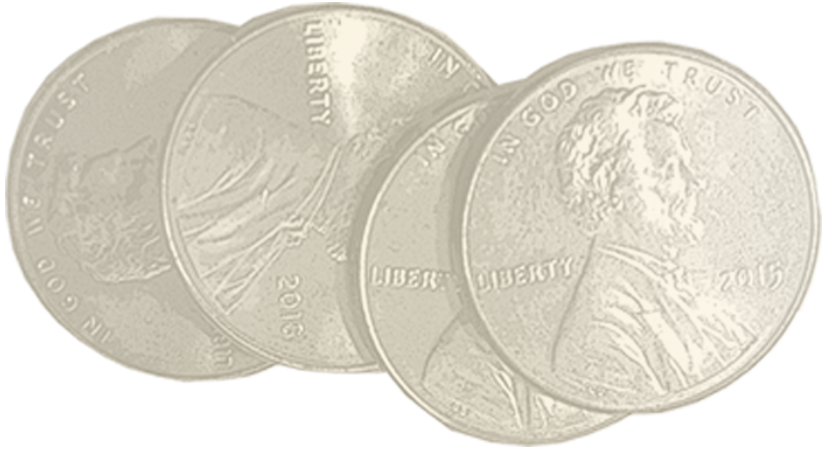
Steve Adams has a 3-year-old daughter and a 2-year-old son, who “watch everything that I do.” A former collegiate soccer player who trained on the Olympic development team, Adams earned a W. P. Carey MBA in 2005 and now develops real estate for Adams Craig Acquisitions. Combining his two talents, soccer and finance, allowed him to teach his children a valuable life lesson. “I want to show my kids that individuals can make a difference if they use their gifts in life to help others who are less fortunate,” Adams says.
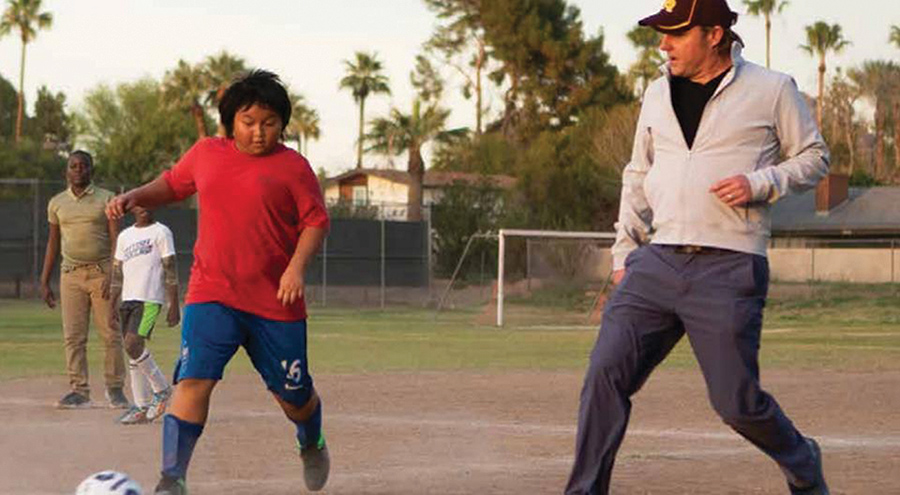
After he sprained an ankle playing in a recreational league tournament, he used the downtime to volunteer coach for North Phoenix Christian Soccer Club and ultimately form Valley-based God Loves Soccer FC, a program for refugee children whose families can’t afford club soccer. The organization’s mission is to teach responsibility and perseverance through sports and faith. Adams and his wife, Cynthia, who also earned an MBA at ASU in 2005, realized they wanted to continue helping refugee children. The family established a scholarship in the W. P. Carey School of Business that gives first preference to an undergraduate of refugee status, with second preference to a first-generation student. “Phoenix is one of the largest refugee outlets in the United States, and we can’t think of a better way to support ASU, Phoenix, and our nation than giving children and families from war-torn countries the gift of the American dream through education,” Adams says.
early 20 years ago, Darren Toohey, Bryson Masters, and Jonathan Abramson were focused on supply chain management while they earned their MBAs, taking the same logistics and procurement classes together. After earning their MBAs in 2000, their career journeys varied — from working for Fortune 100 companies to innovative startups.
Now almost two decades since graduating, the trio is together again — this time working for CWT (formerly Carlson Wagonlit Travel), one of the largest global business travel management companies in the world.
A post on LinkedIn ultimately reunited the former classmates. Toohey, senior vice president of global sales at CWT, shared a job opening in his group. After seeing the post, Masters and Abramson reached out to him about the opportunity that fit their unique backgrounds.
“With CWT now focusing on data science, innovative technologies, and becoming a truly digital company, I was looking to hire people with a diverse background that better matched CWT’s future direction,” Toohey explains.
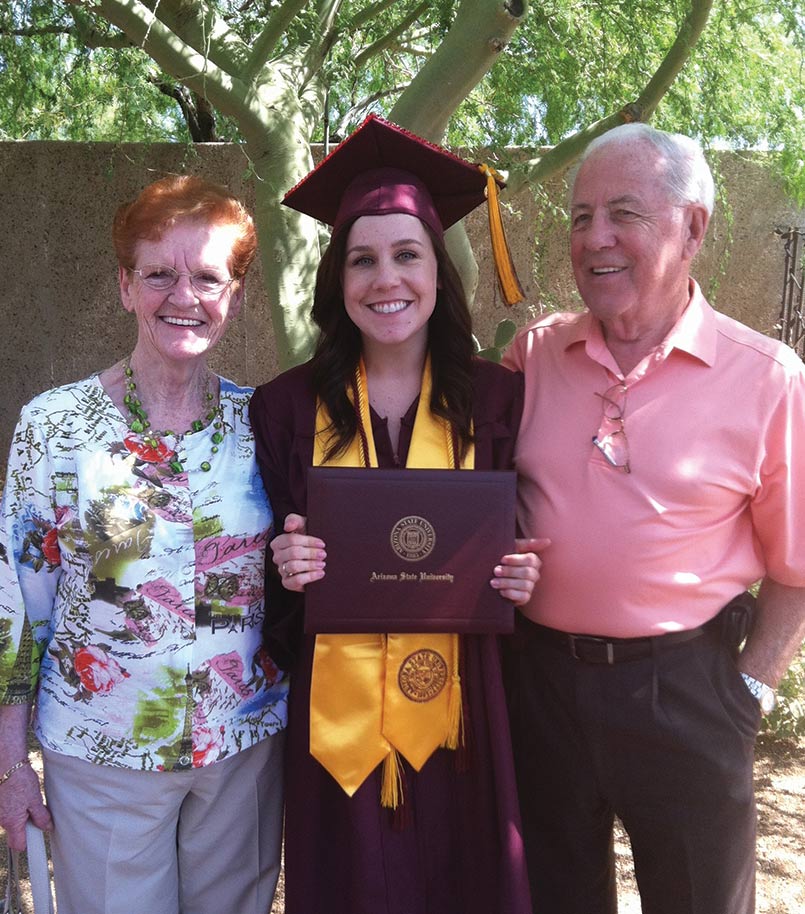

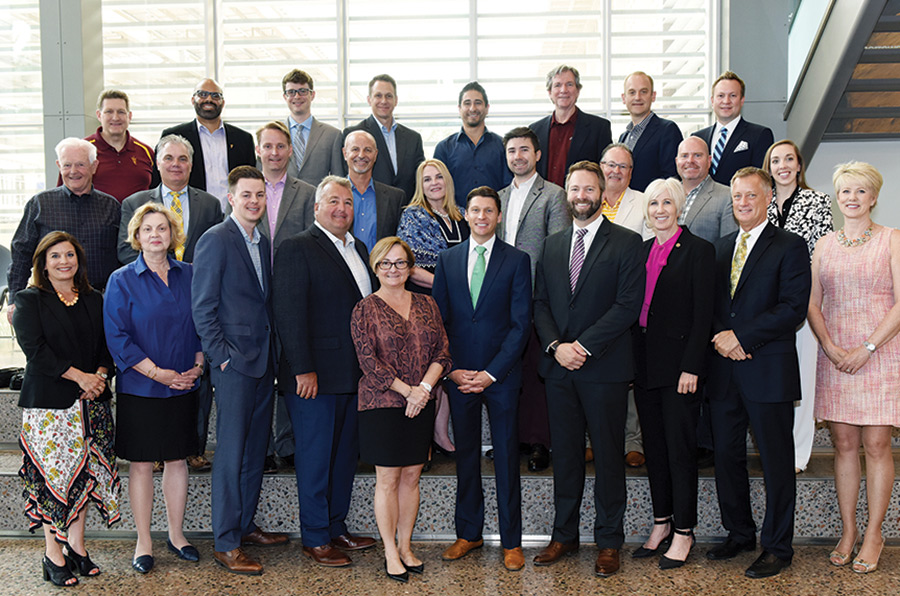
Get to know all of them: wpcarey.asu.edu/sun-devil-100


o summon the right people, activities, and passions in life, you need to declutter — and that doesn’t mean doing the KonMari method. In this case, it means disconnecting from unhealthy relationships and quitting bad habits such as self-sabotaging behaviors and meaningless rituals, says Ernest Sears (MBA ’02), author of “Detox Your Circle, Activate Your Destiny.” Sears, a lifestyle design consultant and relationship strategy coach for SOS Consulting in Phoenix, wrote the book after reaching a turning point and crisis of meaning in his life.
“It’s a process to move from inspiration to manifestation. There are pitfalls along the way that we must be able to either circumnavigate or deactivate,” says Sears, who retired from corporate leadership in 2016. “This is where I use the 13 toxic red flags to help readers stay vigilant about what might show up on the horizon at any time. It is always better to have an idea of what might be coming your way and how to prevent these negative energies from hijacking your destiny.”
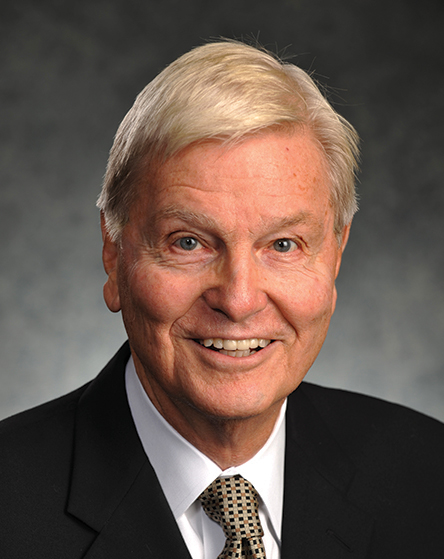
ichard Nosky joined the W. P. Carey School as a lecturer in the Department of Management in 2003 after a successful career in the military and business world. He was the recipient of several outstanding teacher awards, including the 2009 Huizingh Outstanding Undergraduate Professor Award and the Alpha Kappa Psi Outstanding Teaching Award, before his retirement in 2017. Nosky died on June 28. He was 87.
As a former executive at General Electric and a founder of Courier Terminal Systems, he had bountiful practical knowledge to share as a senior lecturer at W. P. Carey. “Richard Nosky taught an applied projects course for many years in our management curriculum. The course was quite demanding and students looking for an easy A stayed away,” shared Emeritus Professor and EMBA Faculty Director Gerry Keim. “Those who did take the course got very valuable practical experience and as a result had more job offers than those who skipped the course. Students loved him, and he taught them lessons that will be valuable for their entire careers.”
W. P. Carey Dean Amy Hillman also remembers Nosky as an inspiring teacher, adding, “He also inspired his colleagues, reminding us that business and life are better when we work hard, but also laugh. He truly lived our philosophy of business is personal.”

Tim Maland
BS Business Administration
1980
Jeffry P. Gossen
BS Business Administration
Thomas J. Leonard
BS Business Administration
Charles E. Maki
MBA
1981
David Y. Thomas
MBA
1982
Katherine S. Sherman
BS Business Administration
1983
Melvin L. Brodman
BS Marketing
1984
Andrea E. Borg
MBA
Curtis W. Moreland
BS Computer Information Systems
Richard D. Sears
BS Marketing
1986
Robert D. Conway
BS Real Estate
1987
James M. Hegarty
BS Marketing
Jacqueline M. Withrow
BS Accountancy
1989
James Placet
BS Finance
George M. Reider, III
BS Marketing
1990
Michael J. Bloom
BS Marketing
1991
Mark V. Sprague
BS Business Administration
BS Computer Information Systems
1993
Abu T. Shaharier
PhD
1996
Keith A. Marple
BS Management
Eric P. Zarkovich
BS Business Administration
1999
Douglas P. Todd
BS Management
2003
Sammy Kwan
MBA
2011
Michael D. Mulcahy
MSIM
2016
Kevin K. Allen
MBA
Tim Maland
BS Business Administration
1980
Jeffry P. Gossen
BS Business Administration
Thomas J. Leonard
BS Business Administration
Charles E. Maki
MBA
1981
David Y. Thomas
MBA
1982
Katherine S. Sherman
BS Business Administration
1983
Melvin L. Brodman
BS Marketing
1984
Andrea E. Borg
MBA
1985
Curtis W. Moreland
BS Computer Information Systems
Richard D. Sears
BS Marketing
1986
Robert D. Conway
BS Real Estate
1987
James M. Hegarty
BS Marketing
Jacqueline M. Withrow
BS Accountancy
James Placet
BS Finance
George M. Reider, III
BS Marketing
1990
Michael J. Bloom
BS Marketing
1991
Mark V. Sprague
BS Business Administration
Brett Hoopingarner
BS Computer Information Systems
1993
Abu T. Shaharier
PhD
1996
Keith A. Marple
BS Management
Eric P. Zarkovich
BS Business Administration
1999
Douglas P. Todd
BS Management
2003
Sammy Kwan
MBA
2011
Michael D. Mulcahy
MSIM
2016
Kevin K. Allen
MBA

f course prices on everything have gone up since the Territorial Normal School (the precursor to ASU) was founded in 1885. But not everything moves at the same rate — or for the same reasons. Stamp prices have risen one-sixth as fast as milk, which has been dwarfed by the spiking cost of movie tickets since World War II. And while you may think that coffee has skyrocketed since its resurgence over the past 20 years, it’s moved at roughly the same rate as a boring old loaf of bread.
Territorial Normal School is founded
William Polk Carey is born
Department of Commerce becomes the Department of Business Administration
per hour
College of Business Administration gets accredited by AACSB
per hour
W. P. Carey naming
per hour
Fleischer Scholars program launches
per hour
Today
per hour
Connect with us and share your thoughts:
wpcarey.asu.edu/linkedin
facebook.com/wpcareyschool
@WPCareySchool
wpcarey.asu.edu/linkedin
facebook.com/wpcareyschool
@WPCareySchool



